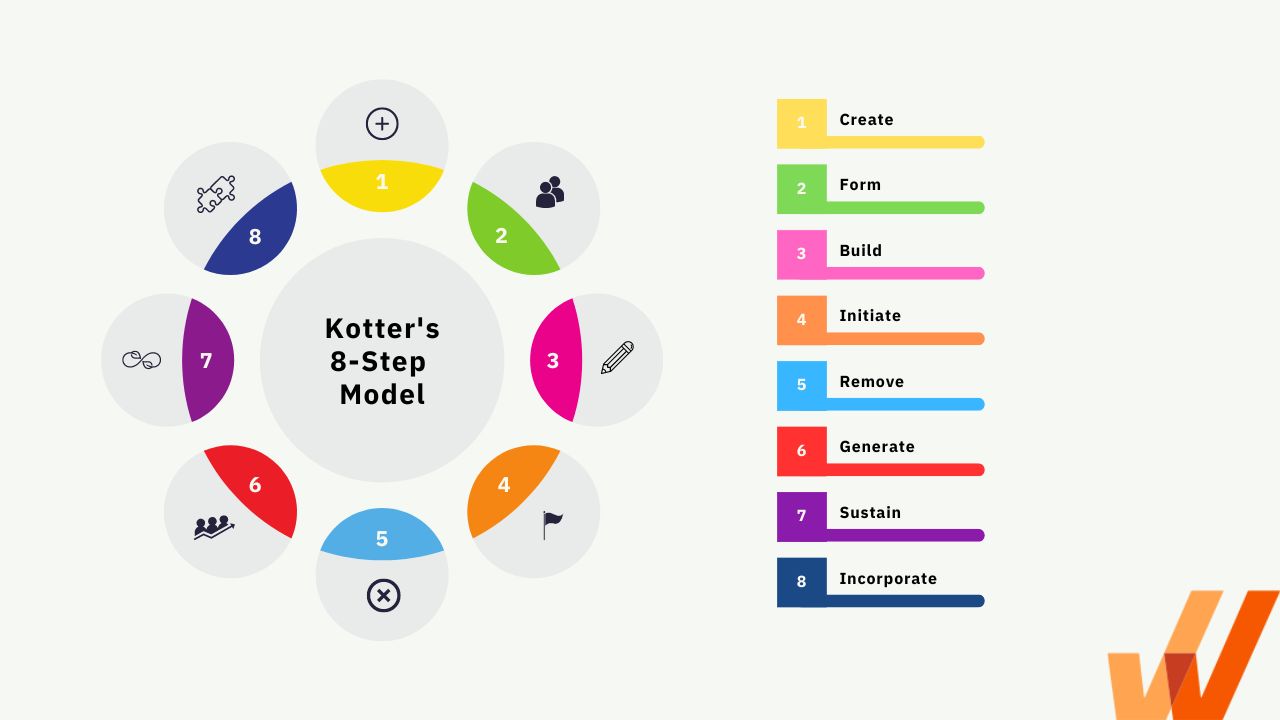The Kübler Ross Change Curve in the Workplace (2024)
- Published:
- Updated: July 15, 2024


Organizational change disrupts the status quo and triggers different emotional responses from employees, often resulting in internal resistance to change and harming the success rate of change projects.
Organizations can anticipate negative responses and support employees through transitional periods by leveraging the Change Curve.
The Change Curve is a popular change management model that breaks down projects into stages of personal transition. It provides guidance and performance support to help predict negative reactions and overcome adoption barriers.
In this article, we’ll break down the change curve, explore its five stages, how to limit the impact of change projects, and how you can apply learnings from the change curve model to your upcoming initiatives.
What Is the Change Curve?
The Change Curve, or Kübler Ross’ Change Curve Model, was created by the Swiss-American psychiatrist Elisabeth Kübler-Ross in 1969. It depicts 5-stages of grief denial, anger, bargaining, depression, and acceptance.
However, the utility of this model also extends to the corporate world, to better understand the emotional turmoil faced by an employee due to any change initiative at the workplace, such as a new software implementation and business process improvement.
Change practitioners may implement this model to identify any barriers to change projects early on and strategize accordingly.
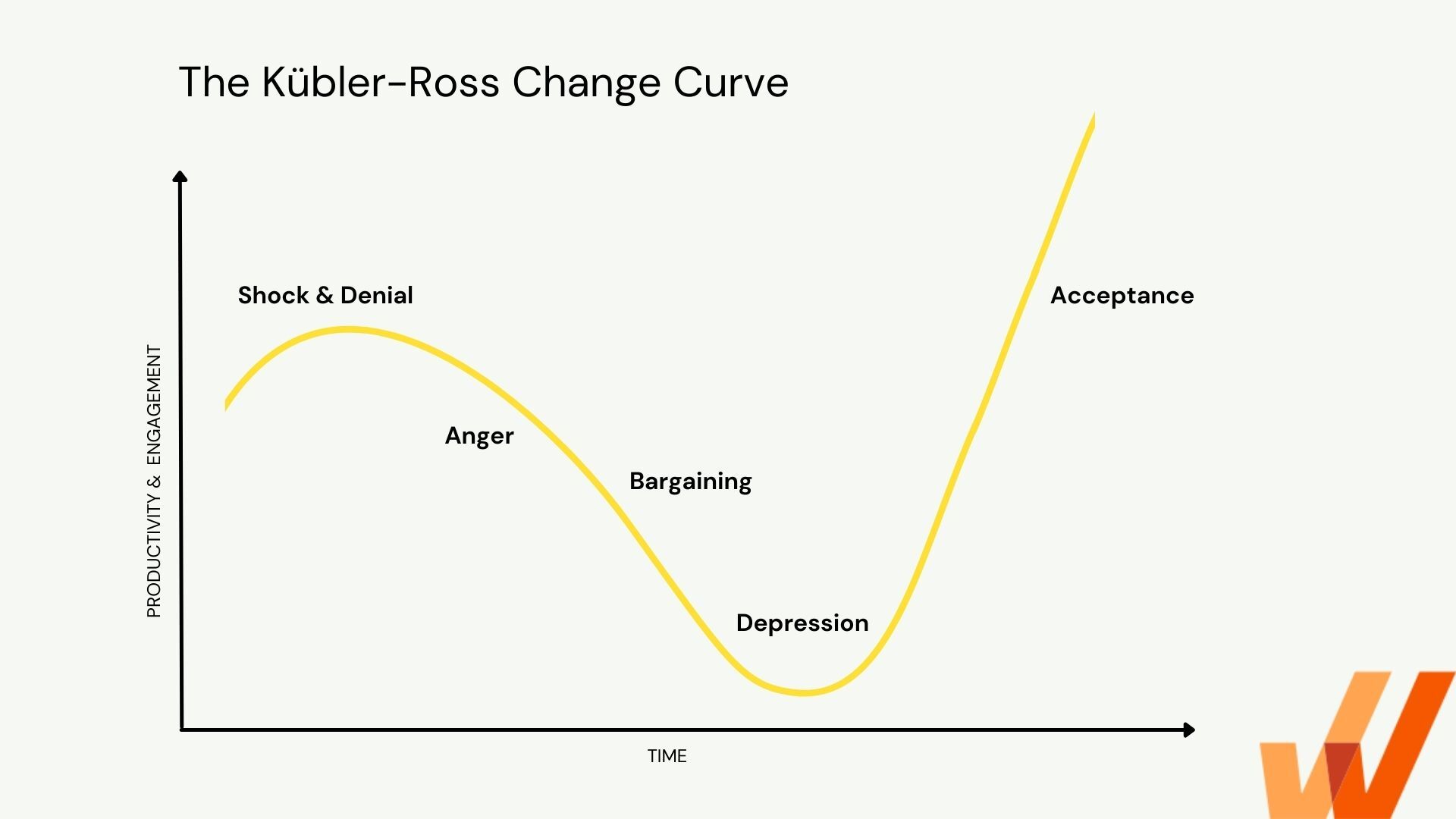
5 Stages of the Kübler Ross’ Change Curve Model
Here are the five stages of natural emotional responses highlighted in the Kübler Ross’ Change Curve Model:
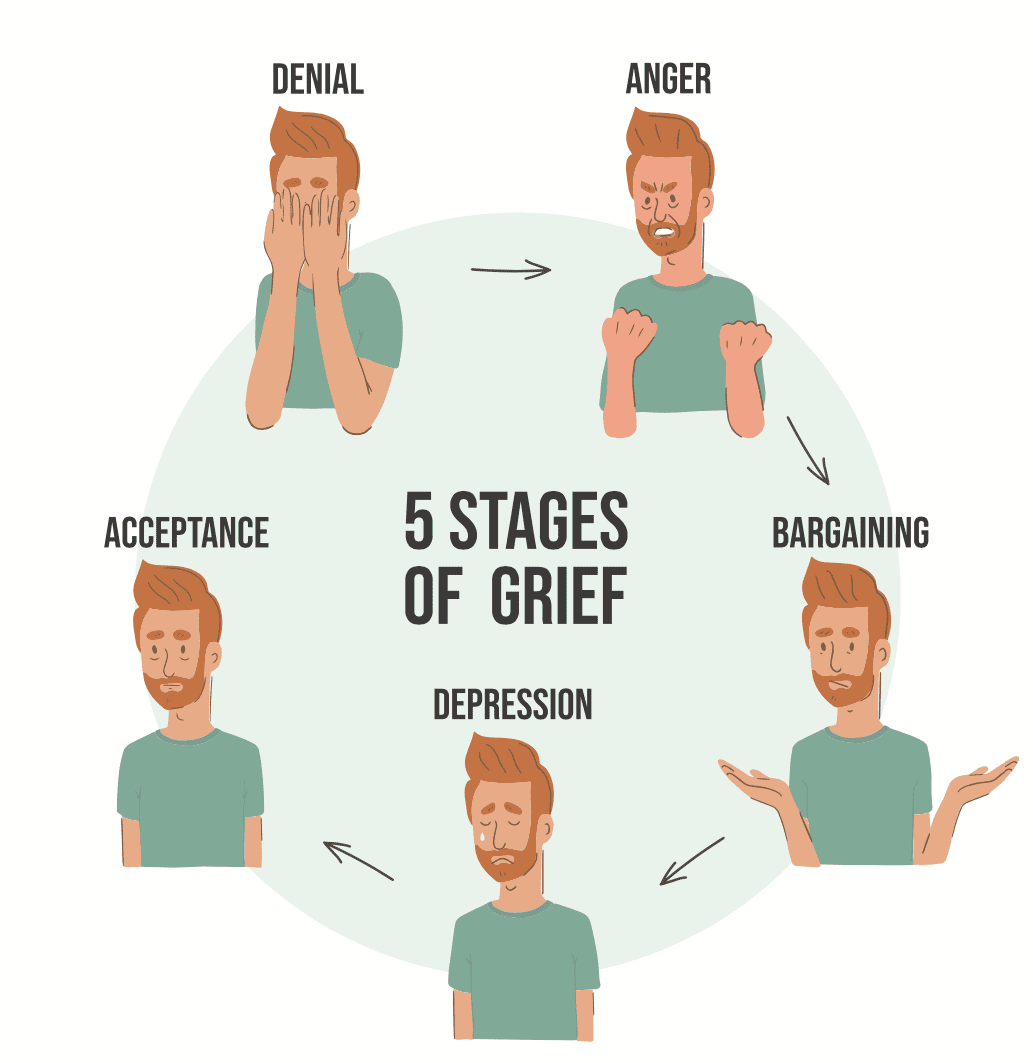
1. Denial
The first stage is shock, followed by denial. In this stage of the change curve, an individual develops defense mechanisms to deflect the actual occurrence of the change.
This leads to a steep decline in productivity as employees cling to past processes or individual expectations, leading to a disconnect from reality. This is typically due to a lack of information on the change, being comfortable with the status quo, feeling that they’re threatened, and the fear of failure or doing something wrong.
This stage is typically short-lived. However, the shock and denial period can be extended if employees are inexperienced with change or have convinced themselves the change will not actually happen.
Constant, clear, and transparent communication is key to overcoming the challenges of the denial stage.
2. Anger
When the reality of change sinks in, it’s manifested in the form of fear or anger. Any change initiative has the potential to spiral out of control in this stage, resulting in significant change failures.
Reactions in this stage may be accurate, as employees may be exposed to risks associated with the implementation or new workloads they will need to take on. Many times, employees will fear unwarranted or irrational consequences of the change
3. Bargaining
Once an individual crosses the anger stage of the change curve, they attempt to salvage the situation by exploring the path of least objection. They may try to negotiate and find a compromise.
This stage may increase productivity as employees feel they can negotiate the reality of change, but its short lived. This is due to employees fixating on small, day-to-day tasks and not looking at the overall bigger picture and important of the change.
4. Depression
In the depression stage, a person loses hope entirely. There are signs of extreme sadness, apathy, isolation, regret, and demotivation. Productivity becomes the lowest at this stage.
Its critical to support employees at this stage in two key ways:
- Reassuring employees that this is normal and others in the organization have the same emotions and feelings.
- Building an individualized plan that shows employees you will support them as they navigate through this difficult time.
5. Acceptance
In the final stage of the change curve, individuals come to terms with the change. Their inhibitions are lowered, they accept the change, and they start to explore new favorable opportunities that result from it. Once employees accept the change, you must cement it into your organizational culture to avoid reverting to old habits.
Employees who have resisted the change begin to show excitement for new opportunities and relief that they’re on the other side of the emotional change journey. They feel that progress has been made and new levels of trust have been built with their peers and organizational leadership.
Benefits of the Change Curve
The Change Curve is a simple, yet effective change model to manage organizational change. Here are the key benefits of the applying the Change Curve model to your upcoming change projects:
- Industry agnostic: The Change Curve is based on observations and in-depth study of the subject matter. The stages in this curve are not influenced by any specific industry and fit well across industries.
- Ease of use: The change curve has straightforward stages and a fairly simple implementation making it relatively easier to use than other change models such as ADKAR and Kotter’s Change Model.
- Objective change management: The change curve focuses entirely on emotional responses to change, which empowers managers to be confident that their teams will respond in a set pattern.
Limitations of the Change Curve
Although the change curve is an effective model, there are a few limitations of this change model:
- Different responses: Different employees will adapt at different speeds resulting in employees being at different stages in the change curve., This often leads to planning and time management issues.
- Observational model: The initial five stages of grief were based on the observation of terminally-ill patients and death. In the case of another scientific model with the strong support of empirical data, it can render this model irrelevant, as it wasn’t originally created with corporate change in mind.
- Connection between the stages: The change curve doesn’t establish a clear interconnection between its stages, as not every individual undergoes all the stages.
Applying the Change Curve to Organizational Change
Here are the most effective action items for implementing the change curve model to support your organization’s change projects:
1. Clear change communication
When team members are in the shock or denial stage, they need reassurance. This can only come from transparent and clear change communication. Change communication must highlight the need for change, vision, strategy, and impact on the stakeholders.
Organizations can overcome communication-related change issues by:
- Creating cross-functional change teams with representation from teams most impacted by the upcoming change.
- Collect change feedback on the upcoming project.
- Have a clear organizational change announcement strategy, from initially announcing the upcoming change project to keeping employees updated as you progress.
2. Avoid roadblocks
When an individual is in a state of anger, self-destructive tendencies may surface. During this stage, change agents must keep an eye out for the potential roadblocks that may slow down your change journey. You must manage this change by being an active listener and observer. Create a safe space for employees to voice their opinions.
You can overcome common roadblocks and internal resistance to change by:
- Continuing to hold roundtable meetings with those most impacted to voice their concerns.
- Make an action plan based on your change feedback to help show your employees who are resisting the change that you’re here to support them.
- Roll out change in beta launches with a phased implementation approach.
3. Offer contextual employee training
When there is a dip in employee productivity as a result of team members trying out and exploring new software, process, or other change, it’s essential to offer personalized employee training programs to help your workforce onboard a new tool or learn a new process – helping to bridge any skill gaps and build confidence.
To visualize its impact, let’s look at the graph below. The yellow curve signifies the overall change curve, while the orange curve depicts how organizations can enable employees with contextual onboarding and on-demand support to minimize the negative impacts and accelerate the change implementation process.
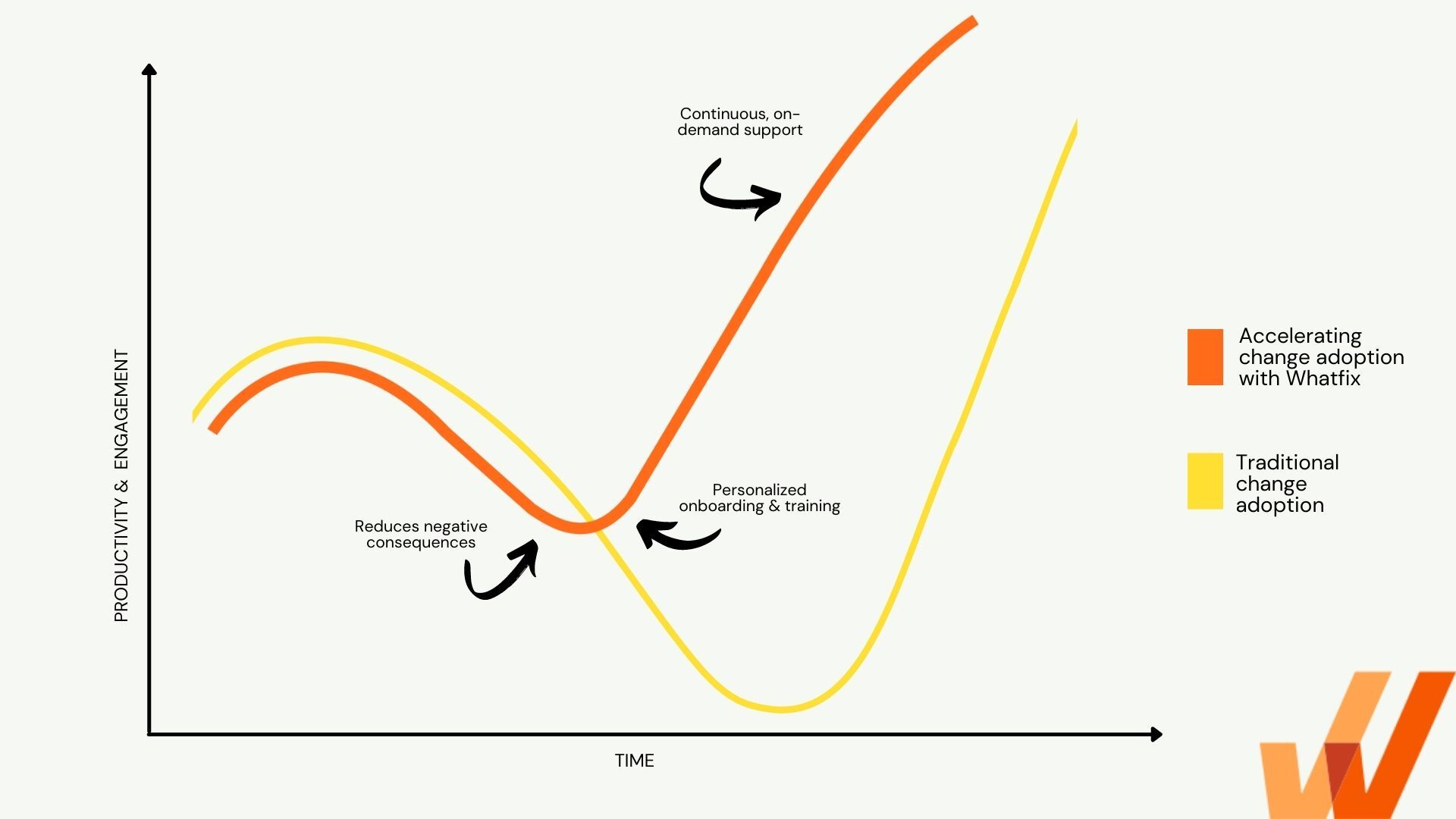
Organizations can support their employees and reduce time-to-productivity for new processes and applications by:
- Providing hands-on training with sandbox IT environments.
- Creating step-by-step documentation on new processes and procedures.
- Enabling employees with in-app guidance that overlays their digital workflows and tasks with experiences like product tours, walkthroughs, task lists, and tooltips.
- Providing on-demand performance support. An end-user support strategy enables employees to overcome friction and troubleshooting issues.
4. Recognize & celebrate critical milestones
A change invokes several emotions and may cause discomfort. However, when employees begin behavioral modification and being to accept the change, organizations must recognize the initial drivers of change and reward them. Once you achieve a critical milestone, be sure to celebrate these wins.
Change leaders can recognize milestones by:
- Sharing how early adopters are overachieving in their goals by using new applications or processes in Slack channels or team meetings.
- Having lunch-and-learns or recorded webinars on how employees are utilizing new systems.
- Creating self-service dashboards with business KPIs tied to the change project.
Even with transformational change leaders and a well-detailed implementation plan, change efforts may still fail. Change leaders must support employees through times of change with change management tools that empower them throughout the change process.
Whatfix is a digital adoption platform that provides organizations with a no-code editor to create in-app guidance and support in the flow of work to help employees quickly become familiar with new technologies and adopt new processes.

With Whatfix, create in-app experiences like:
- Tours and Task Lists for onboarding new employees or supporting team members during software implementations or migration projects.
- Flows that walk end-users step-by-step through complex workflows or infrequently completed tasks.
- Smart Tips that provide additional context at critical friction points in a process.
- Pop-Ups to make team announcements, drive awareness of process changes, remind employees of deadlines, alert team members to new training, and more.
- Self Help that provides a self-help resource center that overlays your enterprise software. Self Help integrates with your SOPs, training documents, LMS, and more – providing support at the moment of need.
- In-app Surveys to collect end-user feedback on change projects and measure training effectiveness.
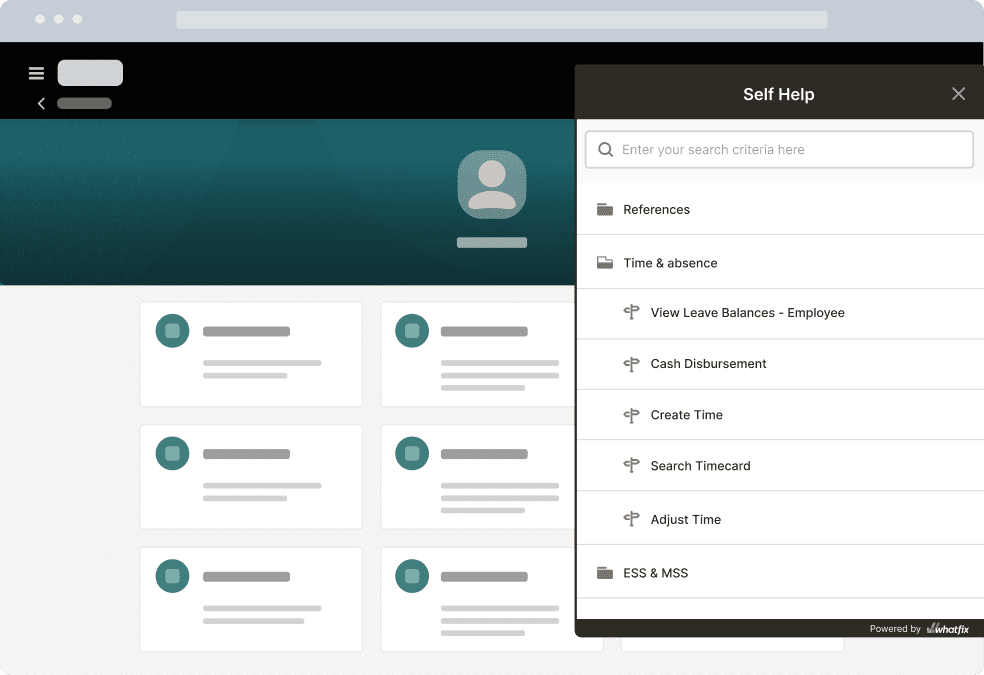
Understand how your users are engaging with your Whatfix content with Guidance Analytics to understand user engagement and content consumption. Understand how many employees are completing their Task Lists, how many employees engaged with a Pop-Up, and what the most searched Self Help queries are.
With Whatfix Product Analytics, track any custom user event to understand completion rates and identify areas of friction. Analyze this data with User Funnels and Journeys, and compare groups of users against one another with Cohorts.
Use this to take a data-driven approach to additional in-app guidance and support content – creating a process of continuous optimization on your digital processes that maximizes your digital value realization on enterprise software.
Ready to get started? Request a Whatfix demo!
Software clicks better with Whatfix's digital adoption platform
Enable your employees with in-app guidance, self-help support, process changes alerts, pop-ups for department announcements, and field validations to improve data accuracy.
Request a demo to see how Whatfix empowers organizations to improve end-user adoption and provide on-demand customer support
Thank you for subscribing!
Thank you for subscribing!

